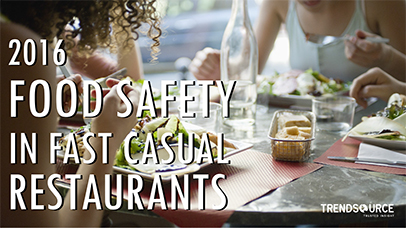A recent survey of attitudes toward food safety in so-called fast casual restaurants found a majority of respondents prefer to see their food prepared in front of them by workers wearing gloves, would complain if they saw unsanitary behavior or conditions, and might return under certain circumstances to a restaurant that had faced a foodborne illness.

Fast casual restaurants are defined as those that do not offer full table service but promise higher-quality food with fewer frozen or processed ingredients than fast food restaurants. Some national chains in this category are Chipotle, Panera, Qdoba and Panda Express.
San Diego-based TrendSource Inc. conducted the survey between Aug. 11 and Sept. 25 by asking 2,969 people aged 18 and older about their perceptions of food safety, food cleanliness, food handling, employee cleanliness and other related issues during visits to fast-casual restaurants.
Most of the respondents were Caucasian, female, between 31-60 years old, had a college education and incomes between $25,001 and $100,000.
Some key findings:
- 65 percent said they eat at a fast casual restaurant a “few times a month” and visit about four different ones during that period;
- 81 percent said that seeing their food prepared increases their trust in its safety and quality;
- 86 percent said they feel their food is “safe” or “very safe” if it was prepared by people wearing gloves;
- 53 percent said they don’t believe restaurant employees wash their hands after using the bathroom or taking a smoke break and before handling food;
- 82 percent said they are “likely” or “very likely” to complain to a manager if they witnessed unsanitary employee behavior or conditions at a restaurant;
- 46 percent said they associated certain types of cuisine with foodborne illness. This “cuisine bias” was mainly directed at, in this order, Mexican/Latin, Asian, India, American and Mediterranean food;
- 70 percent don’t believe there is a lower risk of illness from food that is organic or free of GMOs and/or antibiotics;
- 56 percent said they are “unlikely” or “very unlikely” to return to a restaurant if someone they know became ill from eating there;
- 61 percent said they would return to a restaurant that had faced a foodborne illness outbreak, but most would wait a month or two and until friends ate there without incident and a health inspector or agency had declared the problems fixed; and
- 42 percent said they would complain on social media about food safety concerns, with 88 percent of those using Facebook, 37 percent using Yelp and 24 percent using Twitter to do so.
TrendSource Marketing Manager Heather Parker said that while the recent foodborne illness outbreaks linked to Chipotle Mexican Grill helped prompt the survey, the fast casual chain is not a client.
“We (the marketing team) do market research, so at any given time we’re looking at what people are talking about,” she explained.
TrendSource uses a closed database of about 300,000 “field agents” who may choose to respond to its electronic surveys. The topics change regularly, depending on what the general public happens to be discussing regarding a given industry.
Parker noted that the definition of a fast-casual restaurant varies, but the way TrendSource views the term is “any restaurant that allows you to order at a counter and does not have a drive-thru option.”
However, even that distinction is becoming blurred as more fast-casual chains, particularly regional ones, start installing drive-thrus.
For Parker, the “most fascinating part” of the entire survey was the 7o percent of respondents who said they don’t believe organic food or food free of GMOs and/or antibiotics poses a lower risk of illness.
“I would think that it would be healthier or would be safer, but for this study, that was not the case,” she said.
“The other thing, which wasn’t surprising but interesting, was that 81 percent said seeing their food prepared increased safety and quality,” Parker said, adding that consumers don’t typically see where the food comes from.
Fast casual restaurants are one of the fastest growing segment of the U.S. restaurant industry and are organizing their own events and conferences, such as the annual Fast Casual Executive Summit.
Some reports put fast casual sector growth in the U.S. at nearly 600 percent between 2000-2014, with the yearly growth rate almost double that of the restaurant industry as a whole.
(To sign up for a free subscription to Food Safety News, click here.)
